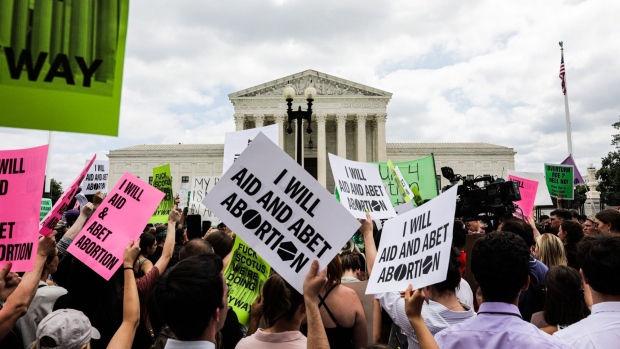Jun 24, 2022
Abortion Patients Crossing State Lines May Hit Tens of Thousands
, Bloomberg News

(Bloomberg) -- Health-care providers in states where abortion remains legal expect a mass migration of patients seeking services in coming months following the Supreme Court decision overturning Roe v. Wade.
“We’re guesstimating that in the tens of thousands of patients, if not more, will need to come somewhere in the Midwest or South — we’ve seen projections of between 13,000 and 40,000,” said Erin King, executive director of the Hope Clinic for Women in southern Illinois.
Care providers in other states that support abortion rights, including Kansas, California and Maryland, have been ramping up to handle more patients. In Illinois, which is surrounded by states where abortion is already banned or likely soon will be, providers have been planning for double to quintuple the current patient volume.
More than two dozen states are expected to ban abortion or had bans that kicked in instantly when the Supreme Court overturned Roe, according to data compiled by the Guttmacher Institute, a reproductive health research group.
“We have been preparing for this for years, and we are as prepared as we could be,” said Colleen McNicholas, chief medical officer for Planned Parenthood of the St. Louis region. “But I do believe this is going to be a public health crisis, and one our country has not dealt with before. We have never had to mobilize folks from 26 states for such basic health care in this country. We will not know the full repercussions of this for years.”
Read More: Supreme Court Overturns Roe, Transforming Abortion-Rights Fight
Illinois may see the biggest percentage increase in out-of-state abortion patients, but Kansas providers project a possible quadrupling of abortion patients, and California Governor Gavin Newsom (D) is proposing $125 million to bolster the state’s abortion network.
Illinois providers have already seen a kind of dry run for what happens when patients in a given state lose access. Recent Missouri restrictions pushed patients into neighboring Illinois, said King from the Hope Clinic, to the point that the number of abortions in Missouri dropped from about 5,000 to about 100 —- while clinics in southern Illinois had to expand to pick up the volume, she said.
When bans hit, King said, what comes first is “mass confusion,” with many patients calling to ascertain if they can still come in. It is key, she said, to get word out that in Illinois, “Abortion is still legal. There are lots of places to access care. And there are lots of teams trying to help you get that care.”
Only now, she and other providers said, many patients will have to travel even farther than before, and need more help with logistics and finance.
In Massachusetts, abortion clinic Women’s Health Services has capacity to treat more patients from out-of-state, said medical director Laurent Delli-Bovi, and has already seen some patients from Texas and other far-flung states that have more restrictions. But she worries those with lower incomes and fewer connections won’t even know it’s an option.
“I think the people we are not seeing are all the people who are going to be harmed,” she said.
Hospitals, which handle about 4% of abortions performed, generally the more complex cases, have also been ramping up in preparation for more out-of-state patients seeking the procedure. In Illinois, hospitals have put together a discounted $5,000 “cash-pay package” for uninsured patients, compared to a typical hospital abortion cost of more than $20,000.
The leader of Mass General Brigham, the largest hospital system in Massachusetts, sent a message to staff Friday saying that “we expect an influx of new patients who will no longer be able to receive care in their own communities.” But, CEO Anne Klibanski added, “We will continue to provide the high-quality level of care, for which we are known, to all patients who walk through our doors, no matter their state or country of origin.”
©2022 Bloomberg L.P.


